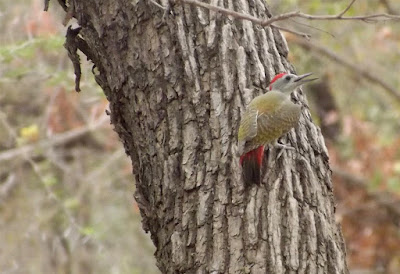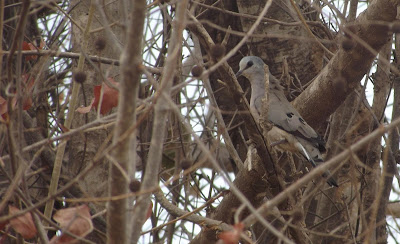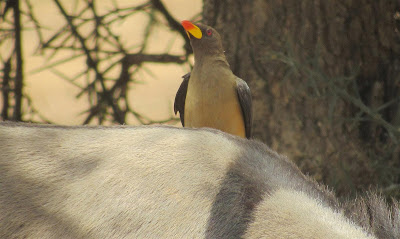The biggest single session on the trip to Guidimakha was a week ago on Sunday. It was at Gouraye which is 45 kilometres south west of Selibaby on the Senegal River. It is on the border with Senegal and only a few kilometres from Mali too.
We birded from about 8am though to 1pm with only a half hour break for drinks.
I suspected birding would be good before we even properly started. The first birds seen, on the edge of the town, were black-rumped waxbill up a tree.
black-rumped waxbill
They proved to be numerous around the town much more so than house sparrow.
village indigobird
We started walking west out of the town with the Senegal River immediately to our left. Ironically there were very few birds over the river itself though some great cormorant made a fly-by.
In the town along our path we across a small group of village indigobird foraging. I hadn't realised this parasitical bird even formed flocks.
gabar goshawk
An adult gabar goshawk was perched on a wire next to the river.
red-billed firefinch
As well as black-rumped waxbill, two other passerines were common around the gardens of the houses around the edge of the town. These were red-billed firefinch and red-cheeked cordonbleu.
red-cheeked cordonbleu
Further away from the town centre were several Gosling's bunting.
greater blue-eared starling
We continued along the side of the Senegal River out of the town. Some starlings caused identification problems but we later dedcued that they were just young greater blue-eared starling. These are blacker overall than adult birds including the size of the dark area on the face.
tawny-flanked prinia
We had seen a flock of tawny-flanked prinia in woods north of Selibaby on our way down on Saturday but failed to take photos. This time we saw two more which were much more accommodating.
white-billed buffalo weaver
In another tree were two white-billed buffalo weaver.
black-winged kite 1
A black-winged kite flew around but we lost sight of it quickly only for it to return minutes late and land conveniently. This was not only an addition to my Muaritanian list but also a lifer. I once believe I caught a glimpse of one in south west Saudi Arabia but not well enough to be sure.
black-winged kite 2
The western red-billed hornbill did not like the kite on their ground. I don't know whether anyone has reported them mobbing black-winged kite before but at one stage the kite was surrounded by no few than six hornbills.
hornbills mobbing a black-winged kite
Previous birding in Gouraye has descibed the area as a wetland. We could see that water must cover much of the area we were walking along for large parts of the year but we found little standing water. However we continued on our way.
We passed a herd of cattle but quickly noticed that one or two of the cattle had birds hanging from them. They were yellow-billed oxpecker. This is exactly the type of species we came to the deep south to find. It is known only in the wettest parts of the country but we weren't sure whether any would be around in the dry season.
yellow-billed oxpecker on a cow
A few tens of metres further along our way we discovered that the wetland had not all dried up. We had simply not travelled enough from the town.
African jacana
A medium sized lake awaited us which was surrounded by trees. African jacana was the first "exotic" species we noticed there.
Intermediate egret
Then we had one of those magical minutes that birding very occasionally throws up.
Mohamed Vall was tracking a squacco heron. I followed his line of sight. I noticed a white heron very close-by. To my delight it was an intermediate egret (and not the more common great white egret).
facial close-up of intermediate egret
A close-up of the face showed a lack of the continuation of the yellow gape past the back of the eye found in the great white egret. This was a new bird for me in Mauritania.
Literally seconds later, I realised there were four greater painted snipe in front of the squacco heron and next to the Intermediate egret.
squacco heron and greater painted snipe
This was another addition to the country list.
I like the way that greater painted snipe just walk away from any perceived threat.
greater painted snipe
A sizeable group of white-faced whistling duck were present at the far side of the lake. A thorough inspection lead to no fulvous whistling duck which remains a target in the country.
white-faced whistling duck
On the far side of the lake we walked into some woodland. There were sounds of several types of dove. One of which we did not recognise. It turned out to be black-billed wood dove which was another first for me in Mauritania.
black-billed wood dove (courtesy of Mohamed Vall)
The temperatures were rising and we decided to turn back. Very few extra species were observed on the way back into town though this time we saw a yellow-billed oxpecker on a donkey.
yellow-billed oxpecker on donkey
Once returned to the town centre, we needed half an hour's drinks break in a shaded shop before we could move on. We decided to go a little east of the main road this time. There was a second wetland here but of a different kind. This was more of a muddy marsh than a lake.
knob-billed duck and other water birds
There were plenty of water birds including knob-billed duck. This was the only place in the area that we saw yellow-billed kite too.
It was hard work getting close to the birds. In some ways this water reminded me of Lake Aleg: muddy and distant from birds.
We left after an hour's observation there.
Overall we saw no fewer than 64 species around the town and surrounding areas. It was everything we had hoped it would be.
However the birding trip was not over. Even the same day and on the way back to our night quarters in Selibaby we found another good birding spot with more additions to our lists. I will blog about that next.
Species seen at Gouraye New additions to my Mauritanian list in bold
White-faced Whistling-Duck 20
Comb Duck 45
Great Cormorant 3
Grey Heron (Grey) 7
Purple Heron 1
Great White Egret 2
Intermediate Egret 3
Little Egret 11
Cattle Egret 18
Squacco Heron 1
Black-crowned Night-Heron 3
Osprey 2
Black-winged Kite 1
Gabar Goshawk 1
Black Kite (Yellow-billed) 2
Black-winged Stilt 5
Spur-winged Lapwing 22
Black-headed Lapwing 4
Greater Painted-Snipe 4
African Jacana 6
Ruff 4
Little Stint 12
Common Greenshank 3
Wood Sandpiper 4
Collared Pratincole 21
Gull-billed Tern 2
White-winged Black Tern 3
European Turtle Dove 2
Mourning Collared Dove 13
Vinaceous Dove 4
Laughing Dove 12
Black-billed Wood-Dove 2
Namaqua Dove 11
Senegal Coucal 4
African Palm-Swift 10
Eurasian Hoopoe (African) 4
Green Woodhoopoe 8
Pied Kingfisher 1
Little Bee-eater 4
Green Bee-eater 6
Abyssinian Roller 7
Ring-necked Parakeet 4
Woodchat Shrike 2
Pied Crow 4
Barn Swallow 35
Common Bulbul 2
Tawny-flanked Prinia 2
Northern Wheatear 2
Long-tailed Glossy Starling 8
Chestnut-bellied Starling 20
Greater Blue-eared Starling 5
Yellow-billed Oxpecker 6
Western Yellow Wagtail 28
Gosling's Bunting 8
White-rumped Seedeater 12
House Sparrow 5
Northern Grey-headed Sparrow 5
Sudan Golden Sparrow 40
White-billed Buffalo-Weaver 2
Red-billed Quelea 160
Black-rumped Waxbill 35
Red-cheeked Cordonbleu 12
Red-billed Firefinch 9
Village Indigobird 5



































































